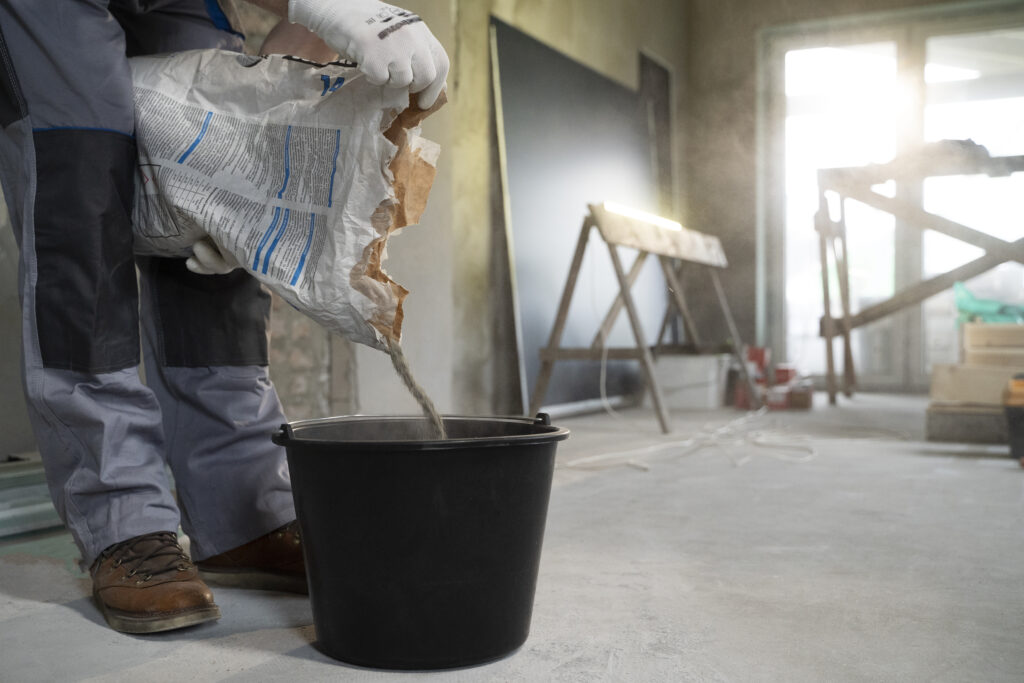The first step to protecting your home starts in the basement. Knowing how to waterproof your basement right is key. It protects your home’s structure.
Good basement waterproofing stops leaks and fights health dangers like mold and mildew. These often grow in wet places. By using professional solutions, you keep your basement dry and secure. This also boosts your home’s value and makes it more comfortable.
Identify the Causes of Moisture in Your Basement
To effectively waterproof your basement, you must understand why it gets damp. Problems can stem from hydrostatic pressure, poor soil drainage, not enough gutter care, and basement condensation. Tackling these issues helps keep your basement dry.
Hydrostatic Pressure
Hydrostatic pressure is a main cause of basement moisture. It happens when water builds up around your foundation in wet soil. The water then leaks through any cracks, making the basement continuously wet. To fix this, ensure good drainage and waterproofing around your foundation.
Improper Soil and Drainage Systems
Bad soil grading and weak drainage systems can make moisture problems worse. If water gathers around your foundation, it’s more likely to get into your basement. Make sure the ground slopes away from your foundation and set up good drainage systems to lower these risks.
Poorly Installed and Maintained Gutters
Keeping your gutters in shape is key to pushing water away from your house. Gutters that are installed wrong or neglected can overflow. This makes the ground by your foundation too wet. Over time, this water might find its way into your basement, causing dampness.
Condensation
Condensation in the basement happens when warm, moist air meets cooler basement walls and floors. This turns the vapor into water, adding to the wetness. Using dehumidifiers and making sure your basement is well-ventilated can reduce condensation. This makes your basement drier and more pleasant to be in.
Inspect and Prepare the Area for Waterproofing
First, make sure to inspect your basement well. Doing this first helps you find any issues that need fixing. This is key before you start waterproofing.
Check for Leaks
Look for clues of leaks like wall stains, wet spots, or mold. These signs mean water is getting in, which could mess up your waterproofing work. Check the window wells, door edges, and structural joints for water entry points too.
Clean and Prep the Surfaces
After spotting trouble spots, clean the basement areas. Get rid of all dust, dirt, and grime on the walls and floors. Cleaning well is crucial for the preparing for waterproofing step because it helps the waterproof materials stick better. Use wire brushes, vacuums, and mold cleaners for the best clean.
Applying Waterproofing Sealants
Keeping your basement dry involves dealing with moisture from inside and outside. Using the right sealants is key to good waterproofing.
Interior Sealants
Interior sealants make a protective layer on your basement walls. This stops a bit of dampness. They help control humidity and resist moisture.
But, they might not stop all water coming in. It’s best to use them with other ways to keep water out.
Exterior Waterproofing Methods
Exterior methods put coatings or membranes on your foundation’s outside walls. This might mean digging around your house. Yet, it’s a lasting way to keep water out.
By tackling the problem from the outside, your basement walls are shielded against water and weather.
Foundation Crack Injections
If your basement walls have visible cracks, sealing them from inside works well. This doesn’t need digging outside. The sealant used stops water from coming in and causing more damage.
This is good for small cracks. It also makes your waterproofing last longer.
Installing and Maintaining Gutters and Downspouts
Getting your gutters installed right and keeping them clean are key. These actions keep your home dry and safe from water harm. When you take care of your gutters, you handle stormwater well. This includes removing trash, looking for leaks, and making sure everything’s connected right.
Good gutters and downspouts move rainwater away from your house. This action stops water damage before it can start. They help keep your basement dry by preventing water from getting in. You might think about putting in gutter guards. They lessen the need for cleaning and help your system last longer.
In places like South Africa, heavy rains can make problems worse. A well-working gutter and downspout system can deal with more water. Don’t forget, checking them often is important. Watch for drooping, rust, or parts that aren’t together. Fixing these issues quickly stops bigger troubles later.
Putting money into the right gutter installation and upkeep means protecting your home from water risks. It keeps your house solid, makes inside air healthier, and protects your money in your home.
Improving Drainage Systems Around Your Home
Home drainage systems safeguard your property from water damage. They guide water away from your foundation. This stops water from seeping into your basement. To improve soil drainage, check the ground slope around your house. A good slope makes rainwater flow away from your home. This lessens the chance of water pooling and seeping in.
Installing interior and exterior drainage systems is key to avoiding basement water seepage. Inside, French drains and sump pumps guide water away. Outside, French drains and waterproof membranes provide extra defense.
Gutters and downspouts are also important. If they work right, they can effectively lead rainwater away. Keep them clean and fix any problems to make sure they work well.
Using both internal and external systems works best for total protection. This keeps your home’s foundation dry and strong.
For more info on keeping your basement dry, see guide to basement drainage systems.
Benefits of Waterproofing Your Basement
Waterproofing your basement helps protect your home from water damage. It makes sure the area below your home is dry and safe.
Better Indoor Environment
The benefits of basement waterproofing are huge. It stops moisture, which cuts down on mold growth. This means the air in your home is cleaner. This leads to a healthier home for your family.
Protection for Basement Floors
Waterproofing also protects your basement floors. Moisture can ruin surfaces over time. Waterproofing keeps floors strong and intact, helping them last longer.
Prevention of Basement Flooding
Keeping your basement dry also stops flooding. When you waterproof, you block water from coming in. This saves you from the headache and cost of a flood.
Protection Against Structural Damage
Finally, waterproofing protects your home’s structure. Water can damage your home’s foundation. By keeping water out, you make your home more stable and safe for the future.
How to Waterproof Your Basement
Keeping your basement dry is key for your home’s health. If you’re facing moisture troubles or just want to avoid them, it’s crucial to waterproof your basement right. Follow these steps to keep your basement safe and dry.
Remove All Standing Water
First, make sure your basement has no standing water. Use a wet-dry vacuum to clear any water. Let the area dry thoroughly. This step stops mold and makes waterproofing your basement more effective.
Apply a Waterproof Coating
Then, apply a waterproof coating to walls and floors. Pick a quality sealant made for basements. It acts as a barrier to keep water out. Ensure you cover every surface well.
Plug Holes and Cracks
Look for cracks in your basement next. Fill them with hydraulic cement or silicone. This keeps water out. Fix any weak spots to strengthen your basement’s defense.
Reseal Windows, Doors, and Window Wells
Last, check all ways into your basement. Make sure to seal windows and doors well to stop leaks. Focus on window wells because they let in moisture. A waterproof sealant here adds extra security against water.
Conclusion
Waterproofing your basement is key to keeping your home in top shape. It keeps the basement dry and blocks leaks. This article has shown you how to do it, from finding moisture sources to improving drainage.
Doing these steps boosts your home’s value and life span. Having good gutters and waterproofing stops leaks. Each action, like sealing up cracks, is vital for a dry basement.
By using this guide, your basement will stay dry and safe. This prevents damage and keeps your home safe. Choosing to waterproof is a wise choice for your home’s future.
FAQ
What causes moisture in my basement?
Moisture can enter your basement through several ways. This includes hydrostatic pressure, and issues with soil, drainage, or gutters. Condensation also adds to the problem.
What is hydrostatic pressure, and how does it affect my basement?
Hydrostatic pressure happens when wet soil around your house pushes moisture through foundation cracks. This can make your basement stay damp.
Why is proper soil grading important for preventing basement leaks?
Correct soil grading stops water from pooling near your foundation. If the grading is off, it can worsen moisture problems in your basement.
How do gutters and downspouts influence basement waterproofing?
Good gutters and downspouts keep rainwater away from your foundation. This is important to avoid water soaking into the ground near your home and entering the basement.
How can you manage condensation in the basement?
You can manage condensation by keeping humidity low and airing out the space. This may involve using dehumidifiers and improving air flow.
How should I inspect my basement for leaks?
Look for water marks, damp spots, or mold in your basement. Fix these issues before applying waterproof coatings for a solid solution.
What’s involved in preparing my basement for waterproofing?
Prep work means cleaning your basement walls and floors well. Removing dirt ensures the waterproofing material sticks better.
What are interior sealants, and how effective are they?
Interior sealants act as a moisture barrier inside your basement. They’re good for small dampness issues but won’t fix major leaks.
What does exterior waterproofing entail?
Exterior waterproofing uses coatings or membranes outside your walls after digging around them. It’s a durable way to stop water from getting in.
How do foundation crack injections work?
Crack injections seal basement cracks with epoxy or polyurethane. It’s an inside job that fixes small flaws without digging outside.
Why is it essential to install and maintain gutters and downspouts?
Keeping gutters and downspouts in top shape is key. They channel rainwater away from your foundation, cutting down basement moisture.
What steps can improve the drainage system around my home?
To better your drainage, fix the slope of your soil. Also, consider adding French drains to lead water away from your foundation.
What are the benefits of waterproofing my basement?
Waterproofing boosts your home’s air quality and its overall health. It prevents water damage to floors, stops flooding, and protects its structure.
What should I do before applying a waterproof coating in my basement?
Make sure there’s no standing water and everything is dry. This ensures the coating sticks well and blocks leaks effectively.
How can I address structural vulnerabilities in my basement?
Fill holes and cracks with the right stuff, like hydraulic cement. Also, keep an eye on seals around windows and doors for added protection.





